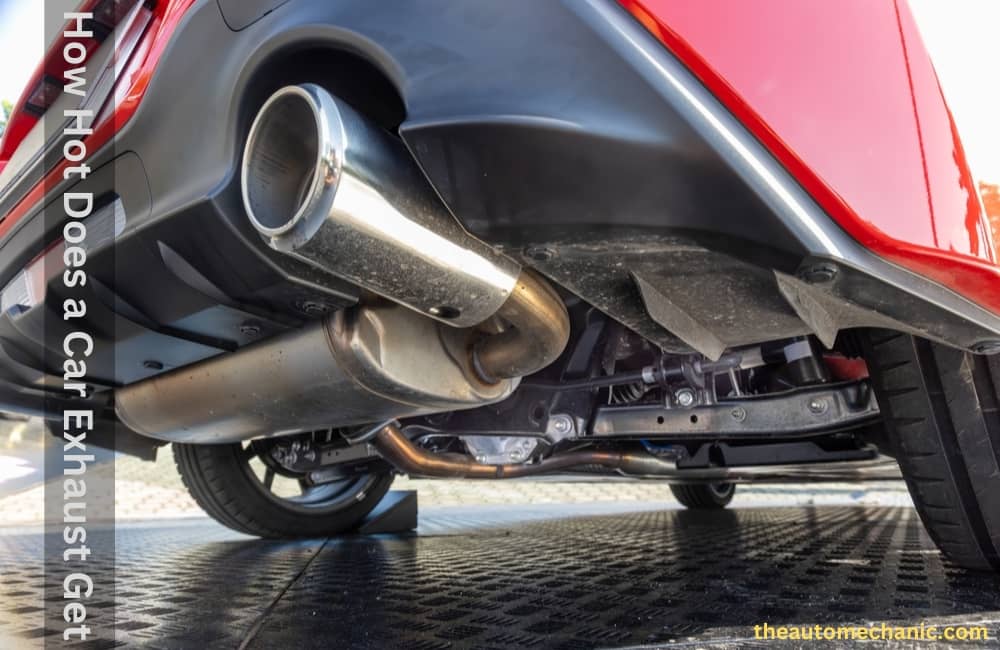How does the process work?
When we heat metals, they turn cherry red at around 1,175 degrees F (635 degrees C). Now, you can imagine how hot an exhaust pipe can be at 850 degrees C. Vehicles on the roads move at different speeds. Studies on the exhaust manifold temperatures have revealed something interesting.
At 50kph (30mph), the exhaust pipes were around 250 degrees F (120 degrees C). At 112kph (70mph), they were 1,020 degrees F (550 degrees C). Thus, we can conclude that when you accelerate, you cause the exhaust manifold to get hotter.
Now you can answer this: how hot does car exhaust get? Exhaust systems get hot because that is how the car works. Regardless, a hot exhaust manifold can cause damage to the surrounding car components. There is something you can do to minimize the chances of that happening. We will discuss that later in the article.
What is an exhaust?
How hot is car exhaust? To understand and answer this question, you must know how an exhaust system works. It is the component of a car that helps to remove gases in the form of smoke. An exhaust system reduces vibrations and noises.
Damage to the exhaust manifold changes the sound of a vehicle. An exhaust system improves motor performance. It consists of several different parts that make it work perfectly. The features of an exhaust system are a muffler, tailpipe, manifold, catalytic converter, exhaust pipe, resonator, and oxygen sensors.
The manifold marks the beginning of the whole exhaust system. It is the component that receives gases from the car engine. Then, it directs the hot fumes far from the engine. An exhaust manifold must be hardwearing and hardwearing to tolerate the hot engine gases. A manifold is generally a cast iron piece of metal with many cylinders for redirecting gases into the front pipe.
An oxygen sensor is also near the manifold. It measures the amount of oxygen in the exhaust gases and relays the information to the ECU to gauge the amount of fuel the engine requires for combustion. A chemical process lessens their toxicity after the engine gases enter the catalytic converter area.
Still, these gases pass through another oxygen sensor that measures the amount of oxygen in the cleansed gases. It promotes the work of the catalytic converter. The less toxic gases now enter through the resonator, the component that alters the sound of your engine.
Next, the gases enter the muffler, a component that further reduces the noise of the exhaust. A muffler has chambers to do its job well. The last component is the exhaust tailpipe that we see in the rear of a car. It exits gases into the air. You now know how an exhaust system works. Next, we will expound on this question: How hot does car exhaust get?
How hot does a car exhaust get?
We will describe the heating process from the start of the exhaust system. Next, learn what gases do to the system’s main components.
Manifold
It is the component that collects engine gases. Manifold gathers the hottest gases. The hottest it can get depends on your driving style. If you are rough on the pedals, the gases could reach 1,200 degrees F (648.89 degrees C). The gases are the hottest near the cylinder heads and the catalytic converter. However, the further away they move from the engine and manifold, the cooler they become.
Catalytic converter
The catalytic converter converts poisonous gases into less toxic fumes. A chemical reaction allows this conversion process to happen continuously. Thus, temperatures can reach 1,000 degrees F (537.78 degrees C). The converter can overheat and reach a double temperature of 2,000 degrees F (1093 degrees C), which turns it into a bright red metal.
Muffler
A muffler is closer to the exhaust pipe but can still hold 300 to 500 degrees F (149 to 260 degrees C). If your engine can reach higher RPMs, the heat at the muffler area will be high.
Oxygen sensors
We already told you how these sensors work. But depending on their location, the heat they can retain can vary. The sensor that sits in the manifold area gets very hot because it receives the hottest engine gases. There are oxygen sensors near the catalytic converter, too. We have seen that this component can get very hot. The sensor near it must receive the impact.
Do you know how to solve this question now: how hot is car exhaust? Earlier, we noted that a car gets hotter as you increase speed. When idling the car engine before you leave, the exhaust system does not get very hot. The exhaust system gets super-hot as soon as you start driving and accelerating. Now, there are other factors to consider when answering this: how hot does car exhaust get? These are:
The status of the Engine and exhaust pipe
One of these is the condition and performance of the engine and exhaust system. If an engine must work harder to produce the necessary horsepower and torque, it will produce more hot gases. Some vehicles have issues with their engines. When an engine has an overheating problem that could increase the typical temperatures we have mentioned here, the engine could be working fine, but the exhaust system has a problem. If so, the exhaust manifold and pipe can get very hot. It is upon you to deal with engine and exhaust system issues.
Length and width of the exhaust pipe
It can affect the answer to this question: how hot does a car exhaust get? It is better to have a longer exhaust pipe because it dissipates most heat as gases come out. In contrast, a shorter exhaust pipe releases engine gases quickly because they travel a small distance. Unfortunately, the gases come out hotter than usual. As a result, a car with a shorter tailpipe will always have higher exhaust temperatures.
How do you deal with hot exhaust gases?
Are you still asking this question: how hot does car exhaust get? It can get super-hot if the conditions are conducive. We promised to tell you more about how to prevent damage to the surrounding components. Most veteran motorists suggest doing the following things:
Try to keep the high temperatures within the exhaust system
You can do so by insulating the exhaust pipes with tape or exhaust wraps. Wrap them around the pipes in a spiral pattern. We noted that the manifold area collects very hot gases. Thus, the correct wrap for this area should have a higher melting point. A good choice is a wrap made from fiberglass. Other remarkable wraps feature silica, basalt, and ceramic materials. The best-quality wrap can minimize exhaust pipe heat by fifty percent.
Shield parts that could succumb to heat damage using reflective, insulating materials
Most new car models have steel or aluminum heat shields. These rest about one or two centimeters from the exhaust manifold, and the air gap between the components propels the extreme heat away.
Manufacturers are now using heat sleeves in new car engines
These sleeves keep all components around the engine safe from heat damage. Like heat shields, heat sleeves feature an aluminum foil with a fiberglass backing. As you might know, fiberglass is a good heat insulator that can robustly reinforce aluminum foil.
The foil reflects radiant heat away from the cable work, hose pipes, and hard lines. An alternative to aluminum foil is mylar foil. It consists of a tiny layer of foil with a polyester resin coating and fiberglass backing and insulation. Mylar is a good choice because it can tolerate temperatures up to 400 degrees F (200 degrees C).
“Mylar or aluminum foils use the same science to reduce exhaust heat. They trap air pockets and prevent the transfer of heat through them. These heat blocks can ensure that no temperatures can damage the car components near the engine and the exhaust system.”
Final Thoughts
How hot does a car exhaust get? We suppose you can answer this question. A car exhaust system will not waste any opportunity to get hot if all conditions are available. If you tow, the engine must work harder to produce the horsepower and torque you need. The downside is that an overworked engine produces more hot fumes that heat the exhaust system.
A damaged engine or exhaust system can also lead to higher exhaust temperatures. We have shared practical ways to deal with an overly hot exhaust pipe. The trick is keeping the heat inside the exhaust system using the recommended technique. One last thing to remember is that you should be careful when fixing a hot exhaust pipe, or else it will burn your hands. We hope we have answered your question about how hot car exhaust is.

Bruce William is a professional content writer and vehicle engineer with extensive car maintenance and repair knowledge. His expertise spans all vehicle parts, offering practical solutions for various automotive issues. Bruce provides valuable insights through his website articles to help readers maintain their cars for optimal performance and longevity.

